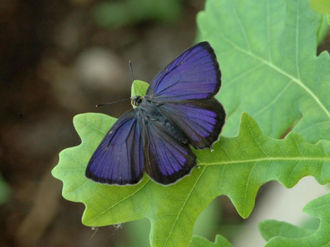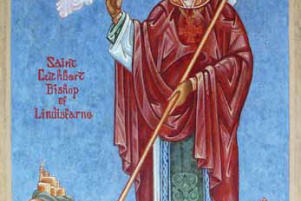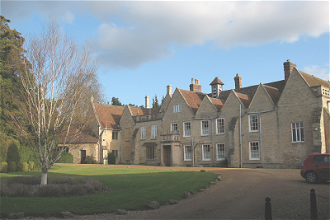White-Letter and Purple Hairstreaks at Turvey Abbey

Purple Hairstreak
The good start to the summer led me to search more carefully than usual for some of our more unusual butterflies and patience was rewarded with the first view locally of a White-letter Hairstreak for ten or more years and the discovery of a colony of Purple Hairstreaks at the bottom of the garden. White-letter Hairstreaks have undoubtedly been with us locally throughout this period, and Purple Hairstreaks too, but both are a devil of a job to see as they spend most of their adult lives perched high in the tree canopy, the former on elms and the latter on oaks.
The adult White-letter Hairstreak seen this year on 13th July was nectaring on a bramble flower in bright sunshine just beyond the tunnel in Abbey Park. It gave clear views of its typical underwing pattern of a band of orange/red edged with black running vertically along the margin of the hindwing with a white zigzag across the remainder of the hindwing, hence its name. It also showed two tails protruding from the bottom corner of this wing which are black with a white tip and probably serve a defensive function causing birds to attack this instead of the head and so allowing the butterfly to get away relatively unharmed. The upperwings are apparently a dull brown with a small orange spot in the corner of the hindwing but, according to the books, no one has ever seen this in the wild so reluctant are the butterflies to open their wings when at rest.
I've now seen White-letter Hairstreaks in at least five locations within two miles of the Abbey, all to the south and east, and largely in areas where the elms have succumbed to Dutch Elm disease and are no longer flowering. It was once feared that this disease would do away with White-letter Hairsteaks altogether but the larvae seem able to survive even on the smaller elms which now grace our hedgerows and generally die off once reaching flowering height. The flight span is little more than a month, my earliest record being this year on 13th July and the latest on 17th August in 1997. Their time in the tree tops is spent mostly at rest, looking for a partner or hoovering up aphid honeydew. This is their favourite source of nectar but they can occasionally be found on the flowerheads of bramble, Privet and especially Creeping Thistle. So they are generally elusive but there are other ways of finding them. The eggs are laid on the girdle scar of elms where this years growth joins that of last year. This again requires careful looking as they are only 0.8mm in diameter but have a distinctive shape, looking like miniature flying saucers with a white rim(at first) surrounding a dark dome. They can also be located by the typical feeding pattern left by the larvae on the leaves: lots of large holes, but other creatures eat elm leaves too so this again needs care. Pupae can also be a give away standing out as dark shadows on the leaves if looked at against the light in late May and June. These will be the trees worth staring at later in the season.
Other Hairstreaks also occur in Bedfordshire but it's only the Purple Hairstreak which is likely to cause confusion around Turvey. The colony at the bottom of the garden was centred on one of the mature oaks and several individuals were seen fluttering in a very characteristic fashion across the leaves, showing first the light and then the dark sides of their wings before suddenly disappearing as they came to rest on a leaf. A close search can then reveal the purple sheen on the upper wings of both the males and females. One was also seen on a bramble flower and looked initially similar to a White-letter Hairstreak but lacking the vertical orange/red band on the hindwing and showing a red-eye-spot instead with a black centre and a short horizontal band below. Purple Hairstreaks are probably to be found wherever oak occurs but like the White-letter are easily overlooked, or should it be easily 'under-looked'.
This year has also seen the spread of Silver-washed Fritillaries to this side of Abbey Park, several sightings of the Scarlet Tiger moth, and a long-hoped for colony of Chimney Sweeper moths in the centre of Abbey Park. These are day-fliers and easily recognised by their all black appearance with white wing tips. Every visit then with the potential for seeing something new.
Br John


















